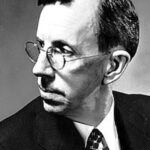J. Hans D. Jensen(25 June 1907 – 11 February 1973) was a German nuclear physicist. He won the Nobel Prize in 1963.
Early Life And Education
J. Hans D. Jensen was born on June 25, 1907, in Hamburg, Germany. He was the son of Karl Jensen, a gardener, and Helene Ohm Jensen. His early education laid the foundation for his future academic pursuits; from 1926 to 1931, he studied physics, mathematics, physical chemistry, and philosophy at the University of Hamburg and the Albert-Ludwigs-Universität Freiburg. Jensen’s intellectual journey continued as he obtained his doctorate in 1932 under the guidance of Wilhelm Lenz at the University of Hamburg. He further honed his expertise and completed his habilitation in 1936, marking a significant milestone in his academic career.
Career And Achievements
Johannes Hans Daniel Jensen academic journey began at the University of Hamburg, where he completed his doctorate in 1932. His career was marked by significant academic positions, including serving on the faculties of the University of Hamburg, the Institute of Technology in Hannover, and the University of Heidelberg. His collaboration with Maria Goeppert Mayer led to the independent proposal of the shell model in 1949, a groundbreaking concept suggesting that atomic nuclei are structured in shells or layers, rather than being a random aggregation of particles. This model was pivotal in advancing the understanding of nuclear structure.
Jensen’s illustrious career was recognized with numerous awards, most notably the Nobel Prize in Physics in 1963, which he shared with Maria Goeppert Mayer for their work on the nuclear shell model, with the other half awarded to Eugene P. Wigner for unrelated work. His contributions during World War II to the German nuclear energy project, particularly in the separation of uranium isotopes, were also notable. After the war, Jensen continued to influence the field as a professor and visiting scholar at various prestigious institutions worldwide. His legacy includes the co-authorship of the book “Elementary Theory of Nuclear Shell Structure” in 1955, further cementing his status as a key figure in nuclear physics.
Notable Events And Milestones
J. Hans D. Jensen earned his Ph.D. at the University of Hamburg, marking the start of a distinguished career that would lead to groundbreaking contributions to science. His work on the nuclear shell model, proposed independently alongside Maria Goeppert Mayer in 1949, earned him half of the Nobel Prize in Physics in 1963, a testament to the model’s significance in understanding atomic nuclei. Jensen’s career was marked by several key positions, including his role as a scientific assistant at the Institute for Theoretical Physics at the University of Hamburg, and later, his professorships at the Technische Hochschule in Hannover and the University of Heidelberg. His involvement with the German nuclear energy project during World War II, known as the Uranium Club, saw him contribute to the separation of uranium isotopes, an effort that had profound implications during and after the war.
Beyond his scientific achievements, Jensen’s impact on history and society is multifaceted. His nuclear shell model not only advanced our understanding of atomic nuclei but also laid the groundwork for future developments in nuclear structure theory. This model has been instrumental in various applications, from medical diagnostics to energy production, reflecting Jensen’s lasting contributions to society and culture. Moreover, Jensen’s international collaborations and professorships at institutions like the University of Wisconsin, the Institute for Advanced Study, and the California Institute of Technology highlight his role in fostering scientific exchange and knowledge dissemination across borders. His work has inspired generations of physicists and continues to influence the field of nuclear physics today.
Jensen’s legacy is not confined to his Nobel Prize; he was also honored with a professorship h.c. at the University of Hamburg, a doctorate h.c. at the Technische Universitat Hannover, and was named an honorary citizen of Fort Lauderdale, Florida. His membership in prestigious societies, such as the Heidelberg Academy of Sciences and the Max Planck Gesellschaft, further cements his status as a respected and influential scientist. J. Hans D. Jensen’s life was marked by significant milestones that shaped his legacy and the field of nuclear physics. His contributions have had a lasting impact on history, enriching our society, culture, and the world at large with a deeper understanding of the fundamental structures that compose our universe. Jensen’s intellectual pursuits and achievements exemplify the profound influence a dedicated scientist can have on the world, transcending the confines of the laboratory to touch the lives of many.
Awards And Honors
- 1947: Honorary professor at the University of Hamburg.
- 1963: Nobel Prize in Physics for the proposal of the shell nuclear model, shared with Maria Goeppert Mayer.
- 1964: Honorary doctorate from the Technische Universität Hannover (today, the Leibniz University Hannover).
- 1969: Honorary citizen of Fort Lauderdale, Florida.
- Member of the Sacri Romani Imperii Academia Naturae Curiosorum (date not specified).
Additional Resources
Books:
- “Elementary Theory of Nuclear Shell Structure” by J. Hans D. Jensen and Maria Goeppert-Mayer provides an in-depth look at the nuclear shell model, for which Jensen was awarded the Nobel Prize.
Documentaries:
- The Nobel Prize’s official website features a video clip from the 1963 Nobel Prize Award Ceremony, where J. Hans D. Jensen received his Nobel Prize.
- The Lindau Mediatheque offers a collection of lectures and documentaries related to Nobel Laureates, including J. Hans D. Jensen.
Museums:
- While there may not be a museum dedicated solely to J. Hans D. Jensen, visiting the Deutsches Museum in Munich, Germany, could provide insights into his field of work, as it houses extensive collections on nuclear physics and related topics.
- The Nobel Prize Museum in Stockholm, Sweden, celebrates all Nobel Laureates and could offer information on Jensen’s contributions to physics.
Online Resources:
- The American Institute of Physics provides biographies and historical information on physicists, which may include details on Jensen’s career and impact.
- Encyclopaedia Britannica offers a detailed biography and overview of J. Hans D. Jensen’s achievements and research.
Observer Voice is the one stop site for National, International news, Editor’s Choice, Art/culture contents, Quotes and much more. We also cover historical contents. Historical contents includes World History, Indian History, and what happened today. The website also covers Entertainment across the India and World.










